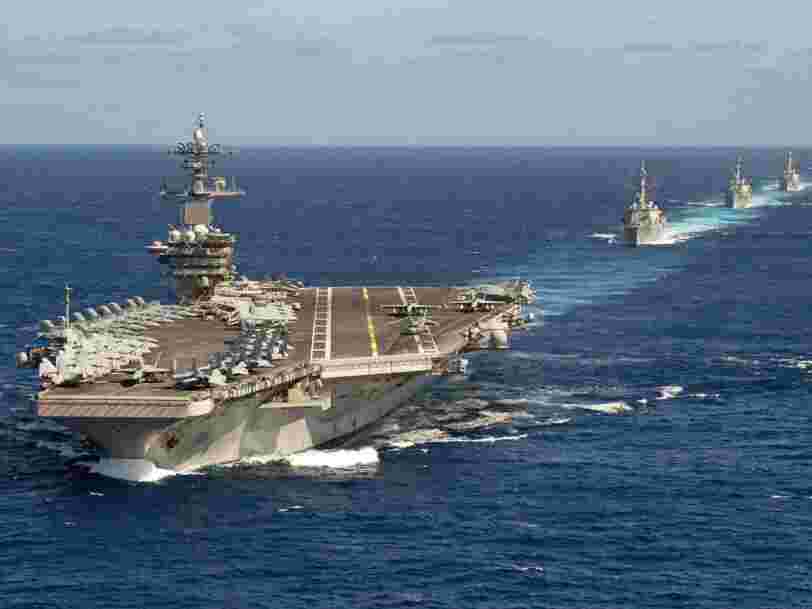Chinese bombers simulated an attack on a US Navy aircraft carrier in the South China Sea
Ryan Pickrell- China
-
Recevoir tous les articles sur ce sujet.
Vous suivez désormais les articles en lien avec ce sujet.
Voir mes sujets suivisCe thème a bien été retiré de votre compte

"The PLA activities highlighted here are the latest in a string of aggressive and destabilizing actions," a US military spokesman said.
- A US carrier strike group sailed into the South China Sea last Saturday.
- The same day, a large force of Chinese military aircraft, including fighters and bombers, flew past Taiwan and into the waterway.
- The Chinese aircraft conducted a simulated attack run on the US aircraft carrier, the US military told Insider Friday, confirming earlier reporting from The Financial Times .
- Visit Business Insider's homepage for more stories .
Chinese bombers recently simulated an attack on a US Navy aircraft carrier in the South China Sea, the US military said Friday, confirming earlier reporting from the Financial Times .
As the Navy's Theodore Roosevelt carrier strike group sailed into the South China Sea this past Saturday, the Chinese military sent eight H-6K bombers, four J-16 fighter jets, and one Y-8 anti-submarine warfare aircraft flying past Taiwan and into the contested waterway.
Tracking data indicates the US carrier strike group entered the South China Sea by way of the Bashi Channel as the Chinese fighters flew through Taiwan's air defense identification zone.
The next day, an unidentified mainland military analyst told China's state-affiliated Global Times that the Chinese move may have been a training exercise intended to "boost the PLA's combat capability against US aircraft carriers," as the bombers could practice launching a saturation attack against the US ships.
Another analyst told the paper that the flights were "likely routine operations" that had nothing to do with the US vessels nearby.
The Financial Times, citing persons familiar with the US and allied intelligence, reported Friday that the Chinese bombers and fighters simulated an attack on the Theodore Roosevelt carrier strike group. The Chinese bomber pilots were also reportedly overheard confirming naval strike orders and simulating the firing of anti-ship missiles.
US Indo-Pacific Command spokesperson Capt. Mike Kafka told Insider in an emailed statement that "the Theodore Roosevelt Carrier Strike Group closely monitored all People's Liberation Army Navy (PLAN) and Air Force (PLAAF) activity, and at no time did they pose a threat to US Navy ships, aircraft, or Sailors."
A defense official said that the Chinese aircraft did not come within 250 miles of the US Navy vessels, putting them outside the estimated range of the YJ-12 anti-ship cruise missiles carried by the H-6K. There was a simulated attack run though, the official said.
Kafka said in the INDOPACOM statement, "the PLA activities highlighted here, are the latest in a string of aggressive and destabilizing actions."
The spokesman said that "these actions reflect a continued PLA attempt to use its military as a tool to intimidate or coerce those operating in international waters and airspace, to include their neighbors and those with competing territorial claims," adding that the "United States will continue to fly, sail and operate wherever international law allows, demonstrating resolve through our operational presence throughout the region."
The US Navy said in a statement last Sunday that the Theodore Roosevelt carrier strike group is on a routine deployment to the US 7th Fleet area of responsibility to conduct maritime security operations.
China objects to the regular presence of the US military in the South China Sea, even though it has operated in the area for decades.
"It does no good to regional peace and stability for the United States to frequently send military vessels and aircraft to the South China Sea to show off its muscles," Chinese Ministry of Foreign Affairs spokesman Zhao Lijian said during a press briefing Monday .
The latest developments in the South China Sea highlight the challenges the new Biden administration will face as it deals with Beijing and China's growing military power.
The new administration and China have already traded jabs over Taiwan. During Monday's press briefing, Zhao told the US to "refrain from sending any wrong signals to the 'Taiwan independence' forces so as to avoid damaging China-US relations and peace and stability across the Taiwan Strait" after the US State Department criticized China's efforts to militarily, economically, and diplomatically pressure Taiwan.
Chinese Ministry of Defense spokesman Wu Qian said Thursday that Chinese military activities near Taiwan are necessary and warned that it would mean war if Taiwan pursued independence from China.
Speaking at the first Department of Defense press briefing of the Biden administration, Pentagon spokesman John Kirby reaffirmed US support for Taiwan's defense but said that tensions "need not lead to anything like confrontation."
Inscrivez-vous gratuitement à notre newsletter quotidienne
Via PakApNews